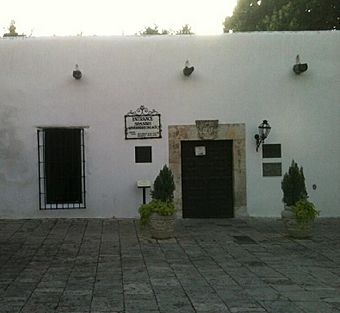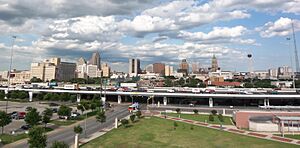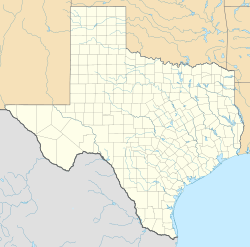Presidio San Antonio de Béxar facts for kids
|
Main and Military Plazas Historic District
|
|

Spanish Military Governor's Palace
|
|
| Location | San Antonio, Texas |
|---|---|
| Built | 1718 |
| NRHP reference No. | 79002914 |
Quick facts for kids Significant dates |
|
| Added to NRHP | June 11, 1979 |
| Designated HD | April 15, 1970 |
The Presidio de Béxar was a Spanish fort built near the San Antonio River. It is located in what is now San Antonio, Texas, in the United States. This fort was built to protect the Mission San Antonio de Valero and the town of Villa de Béjar.
The Presidio de Béxar was started on May 5, 1718. It was founded by a Spanish official named Martín de Alarcón and his group of thirty-five soldiers. The Villa de Béjar was the first Spanish settlement in San Antonio. It included the families of the soldiers and people from earlier trips. The fort also helped Spain keep its claim to the area. This stopped other European countries from trying to take the land.
Contents
How the Fort Was Started
From a place called the Convent of Querétaro, several trips were planned to Texas. This area was very important to the Spanish king and queen. In 1675, a group including Fray Antonio de Olivares was sent to explore the land beyond the Rio Grande. They wanted to see if new settlements could be built there.
Early Explorations
In 1709, Olivares joined another trip led by Pedro de Aguirre. They explored the land between where San Antonio is today and the Colorado River. That same year, he traveled to Spain. He wanted to convince the leaders that it was important to keep the land. He also wanted to build new missions along the San Antonio River. The Spanish leaders agreed to his plans. He stayed in Spain for six years.
In 1716, Fray Antonio de Olivares wrote to the Viceroy of New Spain. He shared his hopes for a new mission. He asked the Viceroy to send families to start a town. He also said that some of these families should know useful skills. This would help them teach the Native Americans to be good citizens.
Building the Mission and Fort
Fray Antonio's hard work paid off. The Viceroyalty officially approved the missions in late 1716. They gave the job of building them to Martín de Alarcón. He was the governor of Coahuila y Tejas.
Fray Antonio de Olivares planned the building of the new mission, San Antonio de Valero. This mission was built from the older Mission San Francisco Solano. He also built the first irrigation ditch in Texas. It was called the Acequia Madre de Valero. This ditch was six miles long. It helped water 400 hectares of land and brought water to the new buildings.
The Presidio San Antonio de Béxar was built on the west side of the San Antonio River. It was about half a mile from the mission. This fort was made to protect the missions and towns in central Texas. It also helped Spain keep its land from other European countries. The presidio was an adobe building with a grass roof. Soldiers and their families lived in simple huts.
The Town of Béjar Forms
As more settlers gathered around the fort and mission, the town of Béjar (or Béxar) began to grow. This town became very important to Spanish Texas. Because it was in the middle of several mission systems, Béxar did not have as many problems as other forts. Even though there were some Native American attacks, the fort's walls were never fully finished. This was because the mission itself was partly built and later became the main walled defense.
On May 5, 1718, the Presidio San Antonio de Béxar was founded. This marked the start of the city of San Antonio, Texas, as we know it today. Martín de Alarcón led this event. About 30 families settled around the area.
In February 1719, the Marquess of San Miguel de Aguayo suggested to the king of Spain that 400 families be brought from other places to live in Texas. In June 1730, 25 families came to Cuba. Then 10 families were sent to Veracruz. Led by Juan Leal Goraz, the group from Veracruz walked to the Presidio San Antonio de Béxar. They arrived on March 9, 1731. This group joined the soldiers who had been living there since 1718. They formed the first government of the city. Their main office was at the Presidio of San Antonio de Béxar.
Life at the Presidio
In 1726, there were 45 soldiers at the fort. Four families lived nearby. Nine soldiers were spread out among the missions. The total number of civilians was 200 people. The soldiers' living areas and the Spanish Governor's Palace were finished in 1749. These buildings housed the military leader. This area became known as the Plaza de Armas.
By 1763, there were 22 soldiers at the presidio. Their job was to defend all five nearby missions. The soldiers sometimes worked as escorts. They also stopped cattle theft and illegal trading. In 1772, other forts in the area were closed. But Presidio San Antonio de Béxar stayed open. It became the main defense in Texas, with 80 soldiers. Béxar was made the capital of Texas. The presidio captain became the regional governor. In 1790, there were plans to fix up the fort, but this never happened.
Later Years and the End of the Presidio
In 1803, 100 soldiers were sent to help the presidio. They came from a group called the Second Flying Company of San Carlos de Parras. They were from Parras de la Fuente in southern Coahuila. These soldiers lived in the presidio's Plaza de Armas (military Plaza). They also used the former mission of San Antonio de Valero.
Even though walls were started in 1805 on the north side of the city, people no longer thought a fort was needed. By 1806, all the troops had moved into the former Alamo Mission, which was now a fort.
In 1811, a retired officer named Juan Bautista de las Casas convinced the presidio soldiers to rebel against their Spanish leaders. Later, the soldiers supported the Spanish leaders again. They joined the army under Manuel María de Salcedo. They fought against the Gutiérrez-Magee Expedition in 1813.
In 1825, Erasmo Seguín was put in charge of supplies for San Antonio. He held this job for ten years. During the Mexican and Texan wars for independence, the presidio soldiers took part in many battles.
In 1835, Domingo de Ugartechea was the leader of the Mexican state of Coahuila y Texas. He was based at the presidio during the Texas Revolution. After the Battle of Béxar in December 1835, Mexican troops left Texas. Texian Colonel James C. Neill briefly commanded Béxar and the Alamo.
The Mexican army took back the town and the Alamo fort at the Battle of the Alamo in March 1836. The Mexican soldiers were there for a short time. The presidio officially stopped existing when the Mexican Army formally surrendered in San Antonio on June 4, 1836. They surrendered to the Béxar Military Chief, Juan Seguin.

See also
 In Spanish: Presidio de San Antonio de Béjar para niños
In Spanish: Presidio de San Antonio de Béjar para niños
- Father Antonio de Olivares
- Alamo Plaza Historic District
- Main and Military Plazas Historic District
- Acequia Madre de bexar


